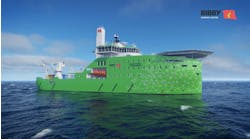Neste's Natura tanker is already equipped with a bow loading system.
Kvaerner Masa-Yards is to convert Neste's 91,000 dwt tanker M/T Futura to accommodate the Statoil patented submerged turret loading system (see Offshore's Norway report earlier in this issue).
STL is a new type of bow loading system which allows oil to be taken directly from a production platform, even in rough seas or Arctic conditions. Kvaerner is performing the conversion at its Masa-Yards Turku New Shipyard, under an FIM65 million contract. (It also built the Futura in 1992.) The vessel will arrive at the yard in August for redelivery by the end of September.
Futura will be used for the first time this year to transport oil cargoes from BP's UK North Sea Harding Field. STL will also be used in Norway on the Heidrun Field, due to start production this summer, and in which Neste also has a stake.
The converted vessel's sister ship, the Natura, is already equipped with a different type of bow loading equipment on the forecastle of the vessel, which permits offshore cargo loading.
Turku New Shipyard's main current project is the construction of four 135,000 cu meter LNG carriers for the Abu Dhabi National Oil Co. Four spherical LNG tanks have already been completed and installed on the first of these carriers: these operations involved lifting separately the lower, middle and upper segments of the 40-metre diameter tanks aboard the hull section, after which final joining took place. The vessels are due to be delivered to ADNOC in 1996 and 1997.
Kvaerner's Helsinki yard is currently converting the 16,000 dwt tanker M/T Lunni for Arctic operations. The ship will then start work for Arctic Shipping Services, a Murmansk-based joint venture specialising in oil transportation: shareholders are Murmansk Shipping Co, Neste Shipping and Kvaerner Masa-Yards.
The vessel will be fitted with an 11.4MW azimuthing electric Azipod-propulsion drive - the most powerful of its type in the world - developed by Kvaerner and ABB Industry. This will replace the existing shaft line and rudder. The FIM85 million will also include installation of new diesel-electric machinery.
One of the spherical LNG tanks for the ADNOC carriers at the Kvaerner Masa-Yards
Aquamaster-Rauma adds thrust
to FPSO construction vessel
Thruster and propulsion equipment for two major offshore vessels is being supplied by Finland's Aquamaster-Rauma. The thruster, a US2001 2,000HP unit, is being fitted in the stern of Coflexip-Stena Offshore's diving support ship Stena Venturer.
The vessel, formerly known as the Essar Stena 1, has just undergone an £8 million upgrade and conversion in Singapore for heavy construction work, particularly for FPSO installations, flexible flowlines and cable lay. This involved lengthening the ship 25 metres to 135 metres and widening it to 27 metres, with a new mid-section containing numerous underdeck chain storage lockers. Deck load will be increased to over 3,000 tonnes.
Aquamaster-Rauma's thruster was installed to provide power for increased ship speeds. The vessel was due to undertake sea trials last month, before heading off to work on Amoco's Liuhua project in the South China Sea.
Normally, Aquamaster-Rauma supplies US2001 units in pairs for 50-tonne tugs, so this is an unusual application. The company has also just won an order from Hays Shipping to supply two retractable 1,700HP, US1701 units for an ROV support vessel at a shipyard in Denmark. This should be in service next year. There is potential for numerous other upgrades of ROV and diving support vessels.
In a separate development, Aquamaster-Rauma is to supply two of its CRP 25 contra-rotating propeller units, each powered at 2,200kW, for a new 84-metre long, Norwegian platform supply vessel. This is being built at the Brattvaag shipyard in Norway, for scheduled delivery to its owner Remoy Management in summer 1996. To aid precision to manouevrability in DP mode, Aquamaster-Rauma is also supplying one of its UL units for the vessel's bow.
The CRP series covers a power range from 1,500-6,000kW. Other applications include tankers and freight vessels. The basic concept always involves two propulsion units and two engines, allowing the vessel to operate efficiently even with one main engine shut down.
CRP was first introduced in 1985: the contra-rotating propellers are designed to provide efficiency of 0.7-0.75, compared to the values for normal propellers of 0.6-0.65. Depending on the thrust loading, the open water efficiency is claimed to be 10-20% higher than that of an optimised single propeller of the same diameter.
This improvement results from three features. First, rotational energy left in the water by the front propeller can be recovered by the aft propeller, leaving no rotational losses in the ultimate slip stream behind the propellers. Second, the thrust is divided into two propellers, meaning that the rate of the thrust loading compared to that of a single propeller is lower, yielding better efficiency. Third, in spite of the higher total blade area, frictional losses are smaller due to the 25-30% lower rate of rotation.
Copyright 1995 Offshore. All Rights Reserved.





